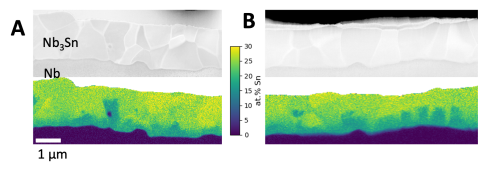Accelerators for cleaner wastewater
Nb3Sn is a next generation material for superconducting accelerating cavities. Unlike traditional niobium cavities, Nb3Sn cavities can operate at higher temperatures, eliminating the need for expensive and complex cryogenic refrigeration systems. As a result, Nb3Sn opens the door to far wider application of high-power beams.In prior efforts to coat superconducting accelerating cavities with Nb3Sn, the Nb3Sn layer exhibited two structures with different critical temperatures. One of these had a high critical temperature (Tc), consistent with expectations for ideal Nb3Sn, while the other had a lower Tc with degraded performance. Working together, CBB grad students Nathan Sitaraman, Zhaslan Barraisov and Ryan Porter combined their ab initio calculations, microscopic sample characterization, and growth expertise to diagnose the problem and modify the Nb3Sn growth procedures, resulting in better uniformity and a 50% reduction in intrinsic energy losses.
CBB is sharing its procedures with scientists at JLAB and Fermilab, who are now assembling the first full-scale Nb3Sn accelerating cavities. Future Nb3Sn cavities could increase the performance of high energy accelerators and enable new environmental applications such as the purification of city wastewater in order to eliminate parasites, pharmaceuticals and other persistent contaminants.
References:
Workshop on Energy and Environmental Applications of Accelerators, S. Posen, M. Liepe, G. Eremeev, U. Pudasaini, C.E.Reece, "Nb3Sn Superconducting Radiofrequency Cavities: a Maturing Technology forParticle Accelerators and Detectors", [Online] Available: https://arxiv.org/pdf/2203.06752.pdf
R. D. Porter, N. Banerjee, and M. U. Liepe, “Dynamic Temperature Mapping of Nb3Sn Cavities,” in Proc. SRF ’21, Lansing, MI, Jun. 2021, doi: 10.18429/JACoW-SRF2021-SUPCAV003 [Online]. Available: https://srf2021.vrws.de/papers/supcav003.pdf
Z. Sun, M. U. Liepe, T. Oseroff, R. D. Porter, T. A. Arias, Z. Baraissov, D. A. Muller, N. Sitaraman, D. Johnson-McDaniel, M. Salim, and C. Dukes, “Surface Oxides on Nb and Nb3Sn Surfaces: Toward a Deeper Understanding,” in Proc. SRF ’21, Lansing, MI, Jun. 2021, doi: 10.18429/JACoW-SRF2021-THPTEV004 [Online]. Available: https://srf2021.vrws.de/papers/thptev004.pdf
Z. Sun, G. Gaitan, M. Ge, K. Howard, M. U. Liepe, R. D. Porter, T. Oseroff, T. A. Arias, Z. Baraissov, M. Kelley, D. A. Muller, J. Sethna, N. Sitamaran, and K. D. Dobson, “Toward Stoichiometric and Low-Surface-Roughness Nb3Sn Thin Films via Direct Electrochemical Deposition,” in Proc. SRF ’21, Lansing, MI, Jun. 2021, doi: 10.18429/JACoW-SRF2021-WEOTEV03 [Online]. Available: https://srf2021.vrws.de/papers/weotev03.pdf

